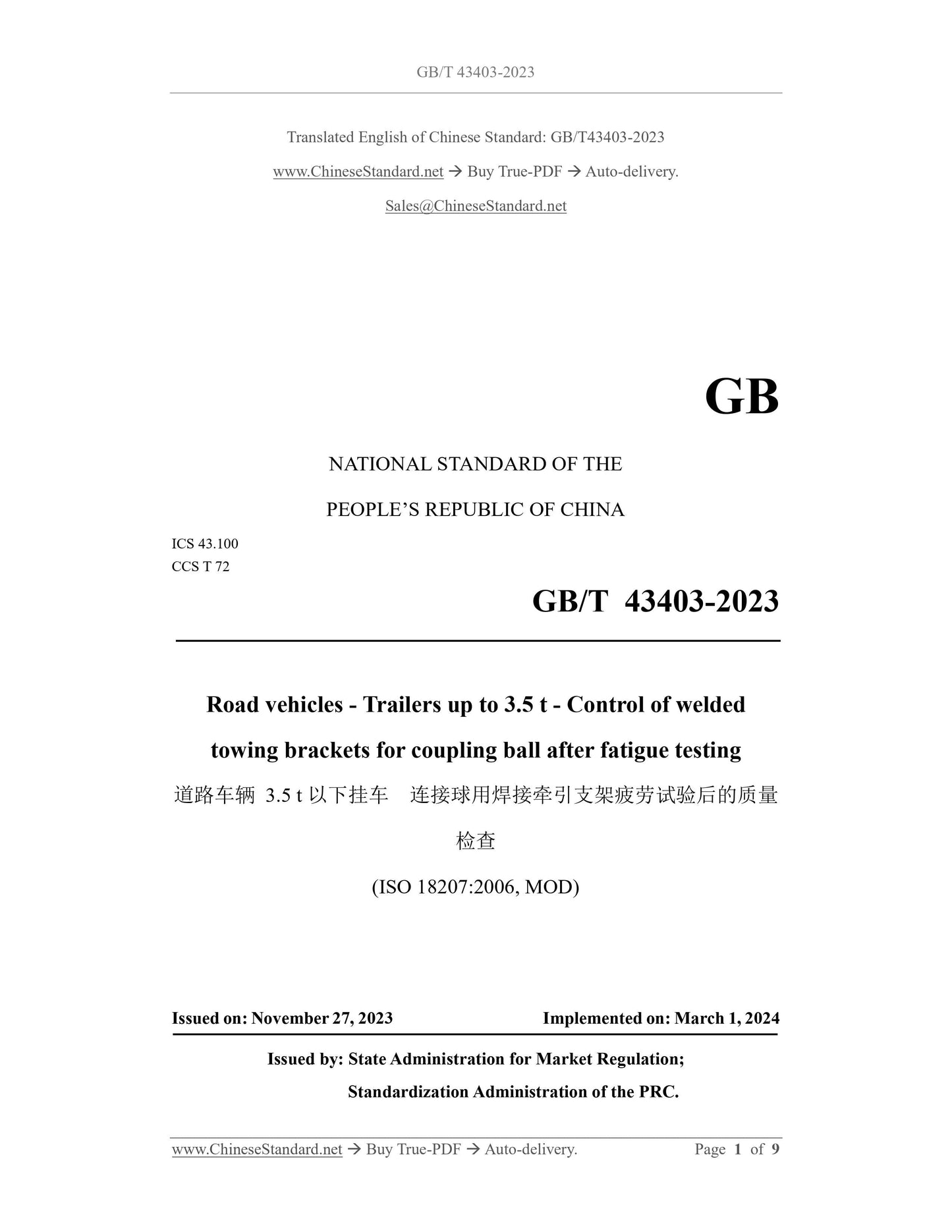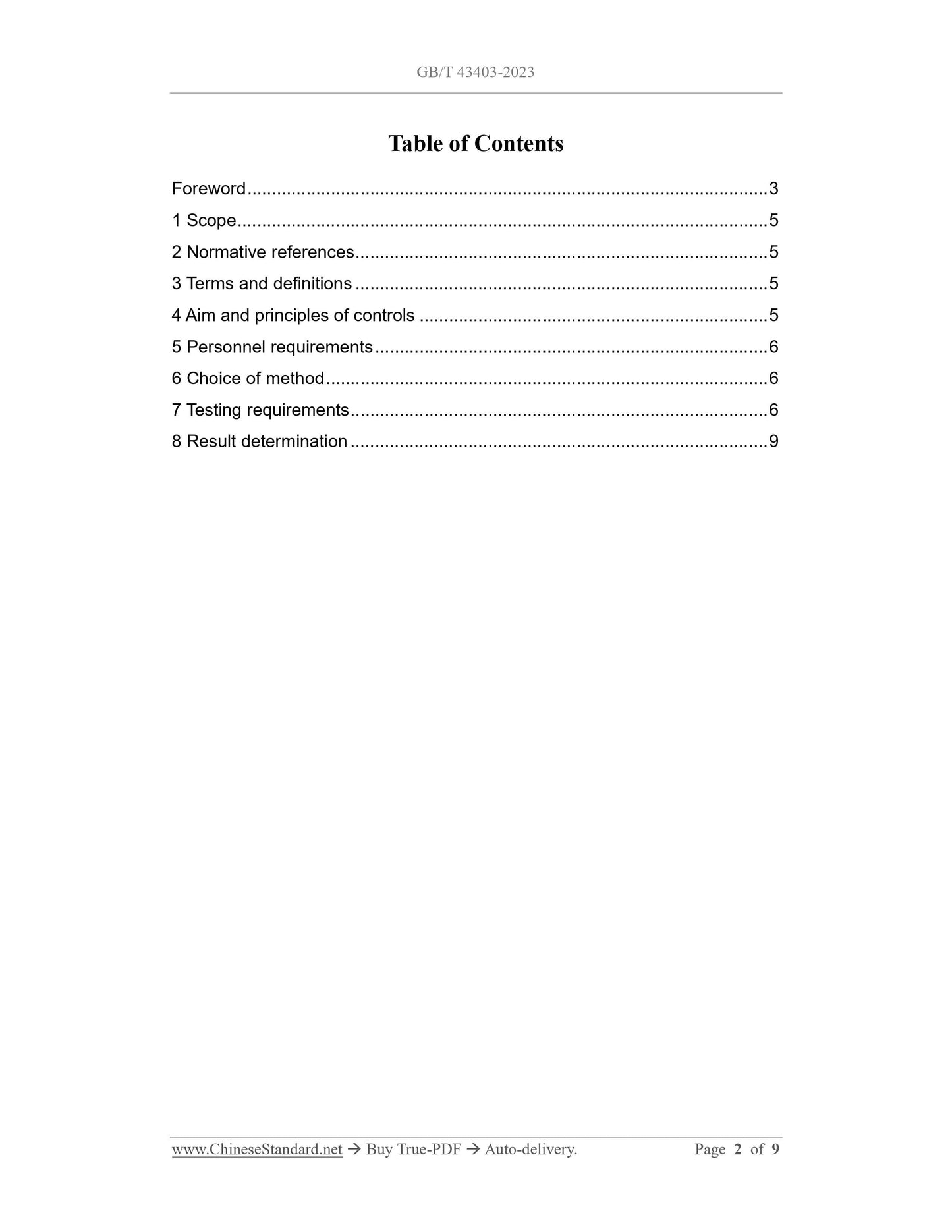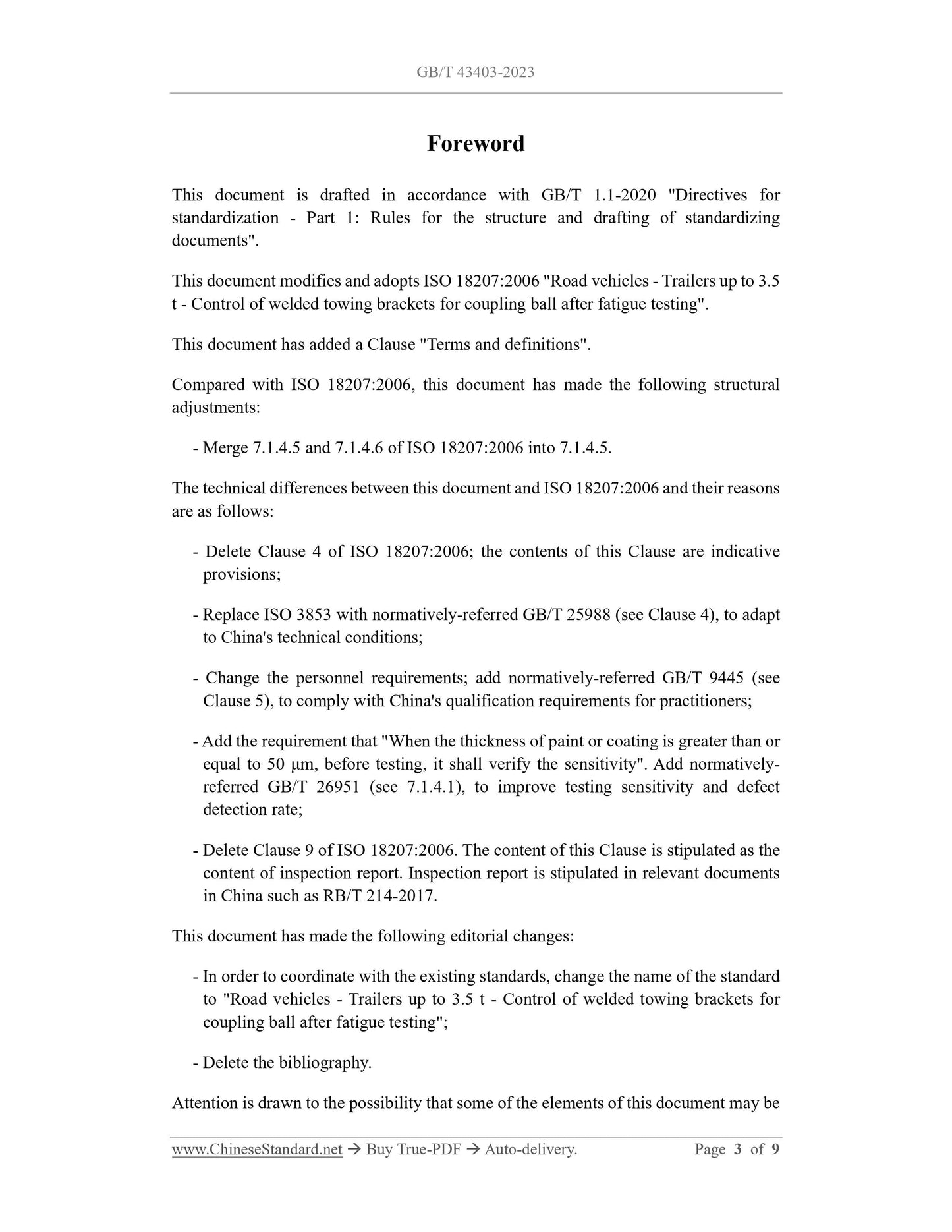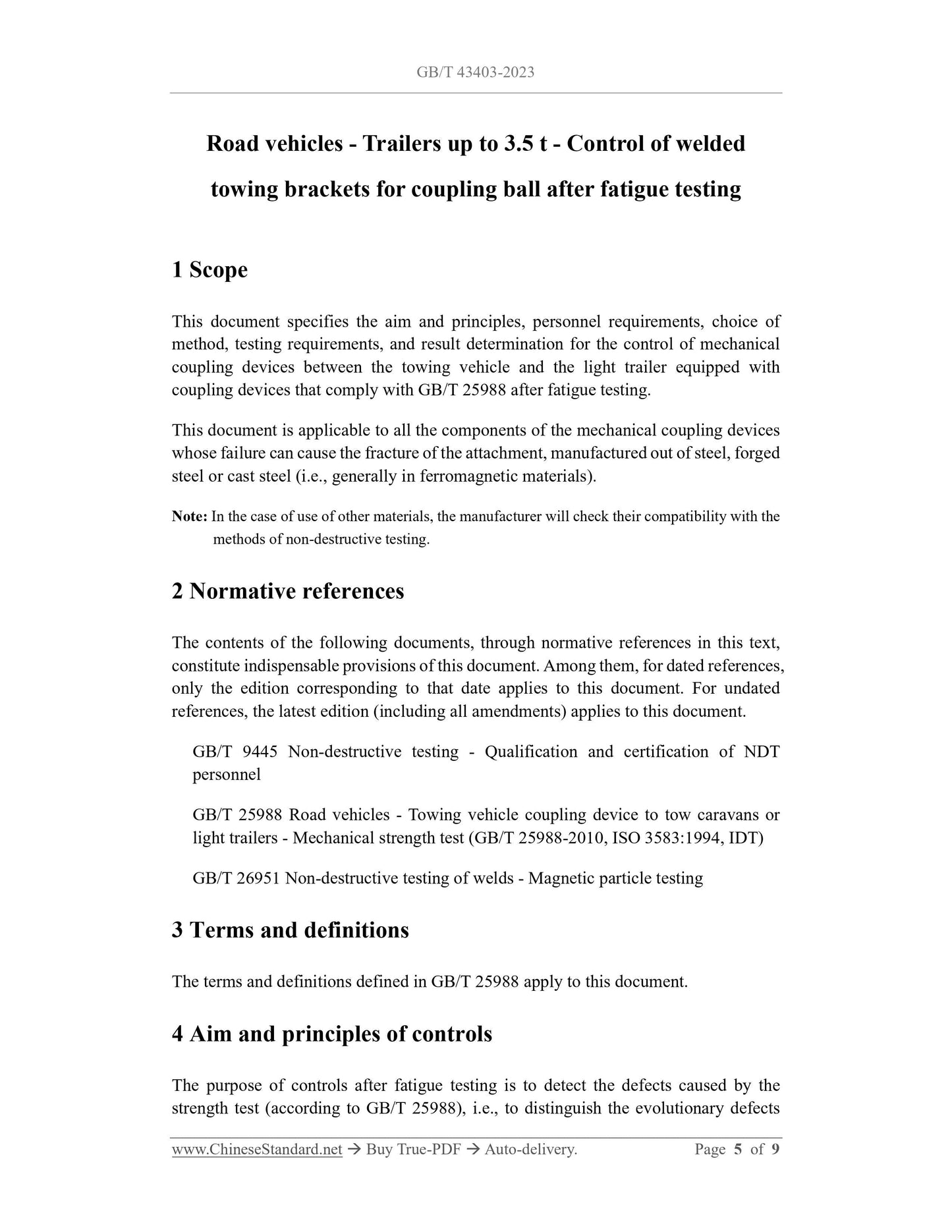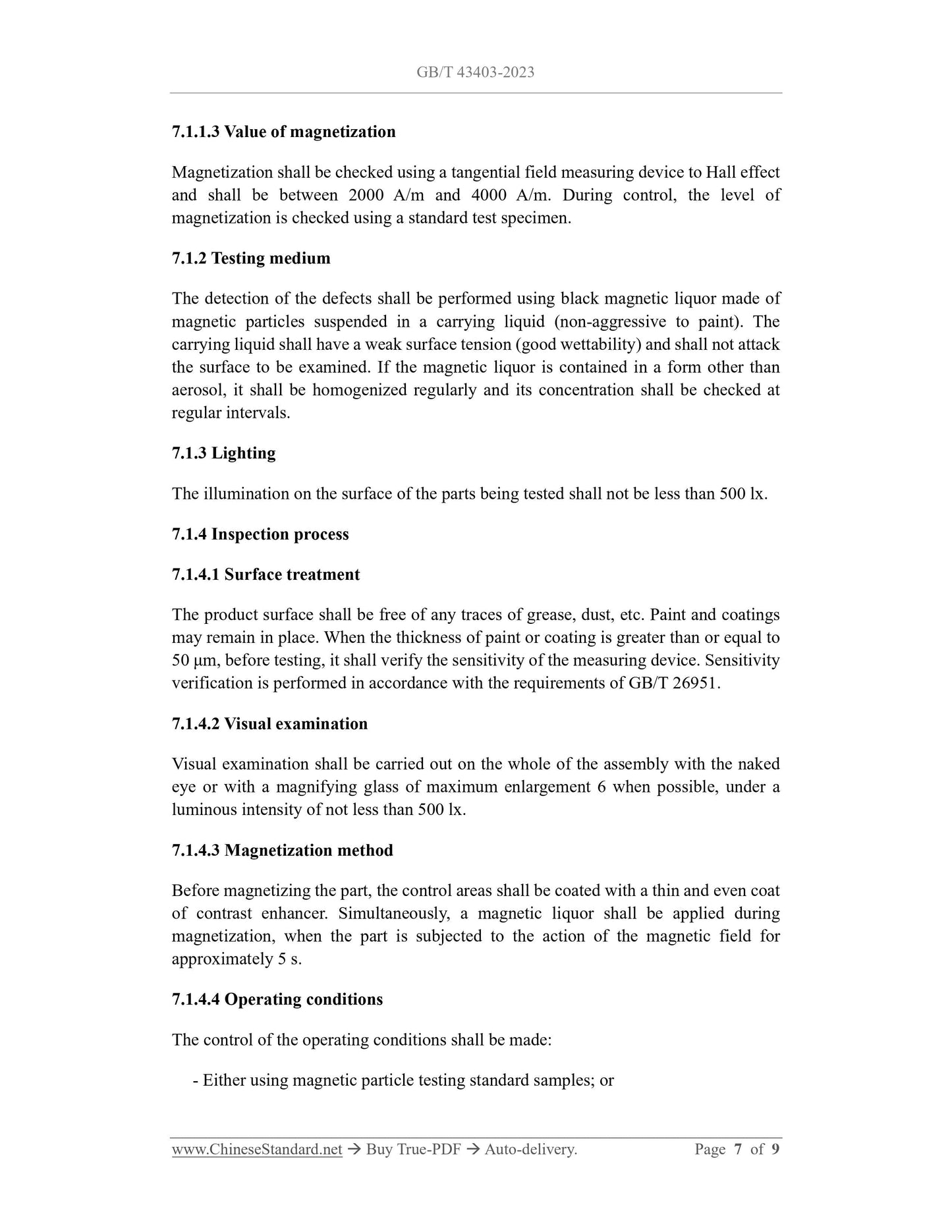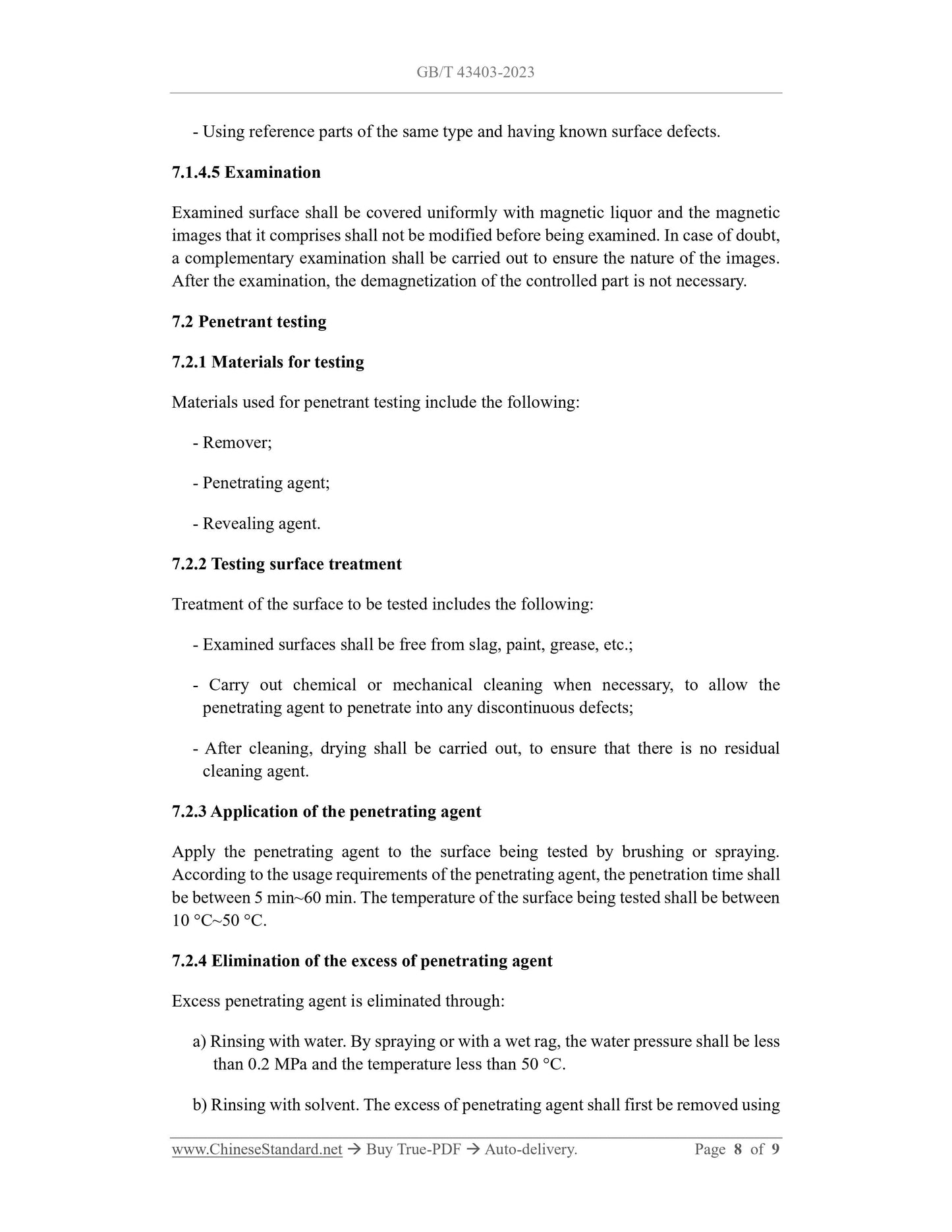PayPal, credit cards. Download editable-PDF and invoice in 1 second!
GB/T 43403-2023 English PDF (GBT43403-2023)
GB/T 43403-2023 English PDF (GBT43403-2023)
Precio habitual
$215.00 USD
Precio habitual
Precio de oferta
$215.00 USD
Precio unitario
/
por
Los gastos de envío se calculan en la pantalla de pago.
No se pudo cargar la disponibilidad de retiro
Delivery: 3 seconds. Download true-PDF + Invoice.
Get QUOTATION in 1-minute: Click GB/T 43403-2023
Historical versions: GB/T 43403-2023
Preview True-PDF (Reload/Scroll if blank)
GB/T 43403-2023: Road vehicles -- Trailers up to 3.5t -- Control of welded towing brackets for coupling ball after fatigue testing
GB/T 43403-2023
GB
NATIONAL STANDARD OF THE
PEOPLE’S REPUBLIC OF CHINA
ICS 43.100
CCS T 72
Road vehicles - Trailers up to 3.5 t - Control of welded
towing brackets for coupling ball after fatigue testing
检查
(ISO 18207:2006, MOD)
ISSUED ON: NOVEMBER 27, 2023
IMPLEMENTED ON: MARCH 1, 2024
Issued by: State Administration for Market Regulation;
Standardization Administration of the PRC.
Table of Contents
Foreword ... 3
1 Scope ... 5
2 Normative references ... 5
3 Terms and definitions ... 5
4 Aim and principles of controls ... 5
5 Personnel requirements ... 6
6 Choice of method ... 6
7 Testing requirements ... 6
8 Result determination ... 9
Foreword
This document is drafted in accordance with GB/T 1.1-2020 "Directives for
standardization - Part 1: Rules for the structure and drafting of standardizing
documents".
This document modifies and adopts ISO 18207:2006 "Road vehicles - Trailers up to 3.5
t - Control of welded towing brackets for coupling ball after fatigue testing".
This document has added a Clause "Terms and definitions".
Compared with ISO 18207:2006, this document has made the following structural
adjustments:
- Merge 7.1.4.5 and 7.1.4.6 of ISO 18207:2006 into 7.1.4.5.
The technical differences between this document and ISO 18207:2006 and their reasons
are as follows:
- Delete Clause 4 of ISO 18207:2006; the contents of this Clause are indicative
provisions;
- Replace ISO 3853 with normatively-referred GB/T 25988 (see Clause 4), to adapt
to China's technical conditions;
- Change the personnel requirements; add normatively-referred GB/T 9445 (see
Clause 5), to comply with China's qualification requirements for practitioners;
- Add the requirement that "When the thickness of paint or coating is greater than or
equal to 50 μm, before testing, it shall verify the sensitivity". Add normatively-
referred GB/T 26951 (see 7.1.4.1), to improve testing sensitivity and defect
detection rate;
- Delete Clause 9 of ISO 18207:2006. The content of this Clause is stipulated as the
content of inspection report. Inspection report is stipulated in relevant documents
in China such as RB/T 214-2017.
This document has made the following editorial changes:
- In order to coordinate with the existing standards, change the name of the standard
to "Road vehicles - Trailers up to 3.5 t - Control of welded towing brackets for
coupling ball after fatigue testing";
- Delete the bibliography.
Attention is drawn to the possibility that some of the elements of this document may be
Road vehicles - Trailers up to 3.5 t - Control of welded
towing brackets for coupling ball after fatigue testing
1 Scope
This document specifies the aim and principles, personnel requirements, choice of
method, testing requirements, and result determination for the control of mechanical
coupling devices between the towing vehicle and the light trailer equipped with
coupling devices that comply with GB/T 25988 after fatigue testing.
This document is applicable to all the components of the mechanical coupling devices
whose failure can cause the fracture of the attachment, manufactured out of steel, forged
steel or cast steel (i.e., generally in ferromagnetic materials).
Note: In the case of use of other materials, the manufacturer will check their compatibility with the
methods of non-destructive testing.
2 Normative references
The contents of the following documents, through normative references in this text,
constitute indispensable provisions of this document. Among them, for dated references,
only the edition corresponding to that date applies to this document. For undated
references, the latest edition (including all amendments) applies to this document.
GB/T 9445 Non-destructive testing - Qualification and certification of NDT
personnel
GB/T 25988 Road vehicles - Towing vehicle coupling device to tow caravans or
light trailers - Mechanical strength test (GB/T 25988-2010, ISO 3583:1994, IDT)
GB/T 26951 Non-destructive testing of welds - Magnetic particle testing
3 Terms and definitions
The terms and definitions defined in GB/T 25988 apply to this document.
4 Aim and principles of controls
The purpose of controls after fatigue testing is to detect the defects caused by the
strength test (according to GB/T 25988), i.e., to distinguish the evolutionary defects
7.1.1.3 Value of magnetization
Magnetization shall be checked using a tangential field measuring device to Hall effect
and shall be between 2000 A/m and 4000 A/m. During control, the level of
magnetization is checked using a standard test specimen.
7.1.2 Testing medium
The detection of the defects shall be performed using black magnetic liquor made of
magnetic particles suspended in a carrying liquid (non-aggressive to paint). The
carrying liquid shall have a weak surface tension (good wettability) and shall not attack
the surface to be examined. If the magnetic liquor is contained in a form other than
aerosol, it shall be homogenized regularly and its concentration shall be checked at
regular intervals.
7.1.3 Lighting
The illumination on the surface of the parts being tested shall not be less than 500 lx.
7.1.4 Inspection process
7.1.4.1 Surface treatment
The product surface shall be free of any traces of grease, dust, etc. Paint and coatings
may remain in place. When the thickness of paint or coating is greater than or equal to
50 μm, before testing, it shall verify the sensitivity of the measuring device. Sensitivity
verification is performed in accordance with the requirements of GB/T 26951.
7.1.4.2 Visual examination
Visual examination shall be carried out on the whole of the assembly with the naked
eye or with a magnifying glass of maximum enlargement 6 when possible, under a
luminous intensity of not less than 500 lx.
7.1.4.3 Magnetization method
Before magnetizing the part, the control areas shall be coated with a thin and even coat
of contrast enhancer. Simultaneously, a magnetic liquor shall be applied during
magnetization, when the part is subjected to the action of the magnetic field for
approximately 5 s.
7.1.4.4 Operating conditions
The control of the operating conditions shall be made:
- Either using magnetic particle testing standard samples; or
- Using reference parts of the same type and having known surface defects.
7.1.4.5 Examination
Examined surface shall be covered uniformly with magnetic liquor and the magnetic
images that it comprises shall not be modified before being examined. In case of doubt,
a complementary examination shall be carried out to ensure the nature of the images.
After the examination, the demagnetization of the controlled part is not necessary.
7.2 Penetrant testing
7.2.1 Materials for testing
Materials used for penetrant testing include the following:
- Remover;
- Penetrating agent;
- Revealing agent.
7.2.2 Testing surface treatment
Treatment of the surface to be tested includes the following:
- Examined surfaces shall be free from slag, paint, grease, etc.;
- Carry out chemical or mechanical cleaning when necessary, to allow the
penetrating agent to penetrate into any discontinuous defects;
- After cleaning, drying shall be carried out, to ensure that there is no residual
cleaning agent.
7.2.3 Application of the penetrating agent
Apply the penetrating agent to the surface being tested by brushing or spraying.
According to the usage requirement...
Get QUOTATION in 1-minute: Click GB/T 43403-2023
Historical versions: GB/T 43403-2023
Preview True-PDF (Reload/Scroll if blank)
GB/T 43403-2023: Road vehicles -- Trailers up to 3.5t -- Control of welded towing brackets for coupling ball after fatigue testing
GB/T 43403-2023
GB
NATIONAL STANDARD OF THE
PEOPLE’S REPUBLIC OF CHINA
ICS 43.100
CCS T 72
Road vehicles - Trailers up to 3.5 t - Control of welded
towing brackets for coupling ball after fatigue testing
检查
(ISO 18207:2006, MOD)
ISSUED ON: NOVEMBER 27, 2023
IMPLEMENTED ON: MARCH 1, 2024
Issued by: State Administration for Market Regulation;
Standardization Administration of the PRC.
Table of Contents
Foreword ... 3
1 Scope ... 5
2 Normative references ... 5
3 Terms and definitions ... 5
4 Aim and principles of controls ... 5
5 Personnel requirements ... 6
6 Choice of method ... 6
7 Testing requirements ... 6
8 Result determination ... 9
Foreword
This document is drafted in accordance with GB/T 1.1-2020 "Directives for
standardization - Part 1: Rules for the structure and drafting of standardizing
documents".
This document modifies and adopts ISO 18207:2006 "Road vehicles - Trailers up to 3.5
t - Control of welded towing brackets for coupling ball after fatigue testing".
This document has added a Clause "Terms and definitions".
Compared with ISO 18207:2006, this document has made the following structural
adjustments:
- Merge 7.1.4.5 and 7.1.4.6 of ISO 18207:2006 into 7.1.4.5.
The technical differences between this document and ISO 18207:2006 and their reasons
are as follows:
- Delete Clause 4 of ISO 18207:2006; the contents of this Clause are indicative
provisions;
- Replace ISO 3853 with normatively-referred GB/T 25988 (see Clause 4), to adapt
to China's technical conditions;
- Change the personnel requirements; add normatively-referred GB/T 9445 (see
Clause 5), to comply with China's qualification requirements for practitioners;
- Add the requirement that "When the thickness of paint or coating is greater than or
equal to 50 μm, before testing, it shall verify the sensitivity". Add normatively-
referred GB/T 26951 (see 7.1.4.1), to improve testing sensitivity and defect
detection rate;
- Delete Clause 9 of ISO 18207:2006. The content of this Clause is stipulated as the
content of inspection report. Inspection report is stipulated in relevant documents
in China such as RB/T 214-2017.
This document has made the following editorial changes:
- In order to coordinate with the existing standards, change the name of the standard
to "Road vehicles - Trailers up to 3.5 t - Control of welded towing brackets for
coupling ball after fatigue testing";
- Delete the bibliography.
Attention is drawn to the possibility that some of the elements of this document may be
Road vehicles - Trailers up to 3.5 t - Control of welded
towing brackets for coupling ball after fatigue testing
1 Scope
This document specifies the aim and principles, personnel requirements, choice of
method, testing requirements, and result determination for the control of mechanical
coupling devices between the towing vehicle and the light trailer equipped with
coupling devices that comply with GB/T 25988 after fatigue testing.
This document is applicable to all the components of the mechanical coupling devices
whose failure can cause the fracture of the attachment, manufactured out of steel, forged
steel or cast steel (i.e., generally in ferromagnetic materials).
Note: In the case of use of other materials, the manufacturer will check their compatibility with the
methods of non-destructive testing.
2 Normative references
The contents of the following documents, through normative references in this text,
constitute indispensable provisions of this document. Among them, for dated references,
only the edition corresponding to that date applies to this document. For undated
references, the latest edition (including all amendments) applies to this document.
GB/T 9445 Non-destructive testing - Qualification and certification of NDT
personnel
GB/T 25988 Road vehicles - Towing vehicle coupling device to tow caravans or
light trailers - Mechanical strength test (GB/T 25988-2010, ISO 3583:1994, IDT)
GB/T 26951 Non-destructive testing of welds - Magnetic particle testing
3 Terms and definitions
The terms and definitions defined in GB/T 25988 apply to this document.
4 Aim and principles of controls
The purpose of controls after fatigue testing is to detect the defects caused by the
strength test (according to GB/T 25988), i.e., to distinguish the evolutionary defects
7.1.1.3 Value of magnetization
Magnetization shall be checked using a tangential field measuring device to Hall effect
and shall be between 2000 A/m and 4000 A/m. During control, the level of
magnetization is checked using a standard test specimen.
7.1.2 Testing medium
The detection of the defects shall be performed using black magnetic liquor made of
magnetic particles suspended in a carrying liquid (non-aggressive to paint). The
carrying liquid shall have a weak surface tension (good wettability) and shall not attack
the surface to be examined. If the magnetic liquor is contained in a form other than
aerosol, it shall be homogenized regularly and its concentration shall be checked at
regular intervals.
7.1.3 Lighting
The illumination on the surface of the parts being tested shall not be less than 500 lx.
7.1.4 Inspection process
7.1.4.1 Surface treatment
The product surface shall be free of any traces of grease, dust, etc. Paint and coatings
may remain in place. When the thickness of paint or coating is greater than or equal to
50 μm, before testing, it shall verify the sensitivity of the measuring device. Sensitivity
verification is performed in accordance with the requirements of GB/T 26951.
7.1.4.2 Visual examination
Visual examination shall be carried out on the whole of the assembly with the naked
eye or with a magnifying glass of maximum enlargement 6 when possible, under a
luminous intensity of not less than 500 lx.
7.1.4.3 Magnetization method
Before magnetizing the part, the control areas shall be coated with a thin and even coat
of contrast enhancer. Simultaneously, a magnetic liquor shall be applied during
magnetization, when the part is subjected to the action of the magnetic field for
approximately 5 s.
7.1.4.4 Operating conditions
The control of the operating conditions shall be made:
- Either using magnetic particle testing standard samples; or
- Using reference parts of the same type and having known surface defects.
7.1.4.5 Examination
Examined surface shall be covered uniformly with magnetic liquor and the magnetic
images that it comprises shall not be modified before being examined. In case of doubt,
a complementary examination shall be carried out to ensure the nature of the images.
After the examination, the demagnetization of the controlled part is not necessary.
7.2 Penetrant testing
7.2.1 Materials for testing
Materials used for penetrant testing include the following:
- Remover;
- Penetrating agent;
- Revealing agent.
7.2.2 Testing surface treatment
Treatment of the surface to be tested includes the following:
- Examined surfaces shall be free from slag, paint, grease, etc.;
- Carry out chemical or mechanical cleaning when necessary, to allow the
penetrating agent to penetrate into any discontinuous defects;
- After cleaning, drying shall be carried out, to ensure that there is no residual
cleaning agent.
7.2.3 Application of the penetrating agent
Apply the penetrating agent to the surface being tested by brushing or spraying.
According to the usage requirement...
Share
